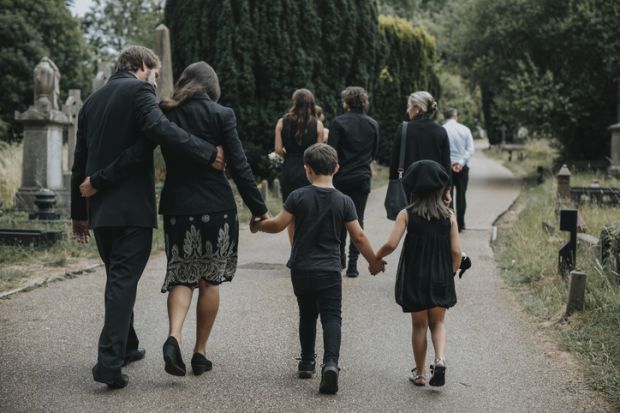The coronavirus pandemic, with its attendant social distancing measures, has transformed the way many people die and the kinds of funerals that can be held.
But can academics who study death offer any insights or policy guidance that could help to improve the situation?
“This is a shocking but not an isolated event,” John Troyer, director of the Centre for Death and Society at the University of Bath, said of the coronavirus crisis. In his recent book, Technologies of the Human Corpse, written before the advent of the pandemic, he explores how death and dying are always intertwined with political, social, cultural and technological developments. The inventions of embalming, photography, refrigeration and railways, for example, all had huge impacts on how the living interacted with the dead, where funerals were held and who was able to attend.
Dr Troyer told Times Higher Education that “the Aids epidemic is very instructive to think through and help get through what is going on now”.
At that time, he explained, “you had a dead body produced and curated as a result of a viral infection that carried with it a stigma – around both homosexuality and drug addiction”. There were concerns about whether the corpse was infectious as well as “issues about legal next of kin excluding friends, lovers and partners, and who had the right to make decisions about the dying person and who had access to the human remains”.
Such disputes would later play an important role in making the case for sex-same marriage as “the legal tool that you need to make decisions around healthcare and claim the human remains”. Yet even at the time, Dr Troyer went on, there were creative responses such as “the non-traditional funeral, which might be described as the celebration-of-life model, where it’s much more of a party that friends and lovers have in a park or a bar”. Around the same time, another thing “that really takes off is the video recording of funerals with camcorders. As we watch new media technology used to record and communicate funerals, it’s a logical extension.”
Yet there was also a much more public dimension to what Dr Troyer foresaw as “an exceptionally busy time for all of us who work in death studies and end-of-life studies”.
Although there had long been “pandemic response plans for what are described as ‘excess deaths’,” he explained, “the management of those plans [in the UK] has been excruciatingly bad. Colleagues have been aghast that the plans we all worked on for the management of these kinds of deaths have been rolled out so late.”
Dr Troyer was “filled with rage”, for example, about the failure of “protocols for families to be with someone who’s dying in hospital with an immuno-suppressive condition or a contagious disease. What is called for is family members to ‘gown up’, put on protective gear, but the problem is that there is not enough protective gear to go around.”
He continued: “I become really agitated when the government say they want family members to be with relatives when they are dying. You have to be able to access the protective clothing – and that is in their own guidelines. That is where there is a failure of planning for, or even imagining, what a pandemic can be like, even though I know those plans are on the shelf.”
Dr Troyer added: “My own opinion is that, as an academic community, we’re going to become more outspoken and robust in presenting what should be happening for things like epidemics and pandemics. If we don’t do that, as people working in this area, we are not doing our jobs.”
Register to continue
Why register?
- Registration is free and only takes a moment
- Once registered, you can read 3 articles a month
- Sign up for our newsletter
Subscribe
Or subscribe for unlimited access to:
- Unlimited access to news, views, insights & reviews
- Digital editions
- Digital access to THE’s university and college rankings analysis
Already registered or a current subscriber?










